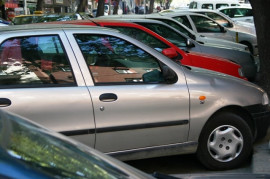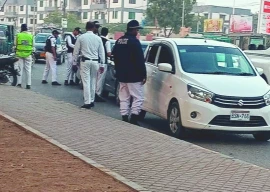The project seems small but if six to seven parks in Karachi are converted into forests it would change the ecological landscape of the city, remarked entrepreneur Shahzad Qureshi.
"I aim to restore the native forests of the region and around three years from now there would be a self-sustaining 15 to 20 feet deep forest. It would be so dense that people won't be able to step into it," he added.
Green Line bus to make Karachi less green
Branching out
Qureshi was inspired to grow an urban forest when he saw a Ted-talk by an Indian eco-entrepreneur Shubhendu Sharma in August, last year.
Sharma's company Afforest is a service provider for creating natural and native forests. "Our mission is to bring back our lost forests, we do it by creating them," reads the description on the company's website.
Sharma pratices Miyawaki methodology to plant forests which helps grow them ten times faster than usual. He has played an integral role in growing more than 100 small-scale forests in different parts of India, Singapore, Netherlands and USA at homes, schools and factories to improve air quality and increase biodiversity.
Qureshi then contacted Sharma and invited him to Pakistan to work on a collaborative pilot urban forest project in Karachi, as more than a 1,000 people lost their lives in the heat wave last year due to lack of greenery in the city. Sharma visited Pakistan in November last year and worked on the project with Qureshi.
"This small piece is just a pilot project to make us aware of the problems which can occur while growing a forest in Sindh," said Sharma while speaking to The Express Tribune. "It's beginning of the beginning of a bigger dream."
Urban forestry: For animals, home is where the tree is
Plant a forest
The forest has about 1,280 plants, ranging from flower, fruits to canopy trees, informed Qureshi. There are around 45 species of trees that have been planted in an area of 400 yards, he added. The park in which the forest is located is over an acre in area.
The land on which the pilot project has been initiated on is government-owned, said Qureshi. He then contacted the horticulture department who gave him the permission to use certain patch of the abandoned area to grow the forest. The Sindh forest department helped me access a few native tress species from their own nurseries, he said.
The cost for the pilot project was quiet high however it can be reduced, he remarked, adding that he is financing the forest and its maintenance at his own expense.
Speaking about the importance of soil, he said powerful soil is better for the growth of the plants. We must put all our organic trash in the soil to strengthen it as it provides adequate energy to the soil and then to plant when it is decaying, he explained. "The organic trash provides life to plants and it helps attract insects, which are integral in creating a natural cycle.
The case for urban trees: Greenery can improve public health in Karachi
According to him, the sewerage water is also useful for plants contrary to what people might think. We have plenty of such water which we are draining into sea but it can be used for the plants, he added.
"It sometimes gives me goose bumps when I see the plants growing which I planted," he said while speaking about his journey so far.
Acting now
Speaking about environmental degradation, Sharma remarked "The damage done to earth is repairable. We believe that our forest can be brought back, but only if we act now."
Qureshi also encouraged the people to start taking ownership of the environment and play their part in improving it. We have plenty of parks and empty places around, people should take the initiative of planting as many trees as possible, he added.
Published in The Express Tribune, July 21st, 2016.











1737796524-0/Untitled-design-(32)1737796524-0-270x192.webp)











COMMENTS (16)
Comments are moderated and generally will be posted if they are on-topic and not abusive.
For more information, please see our Comments FAQ